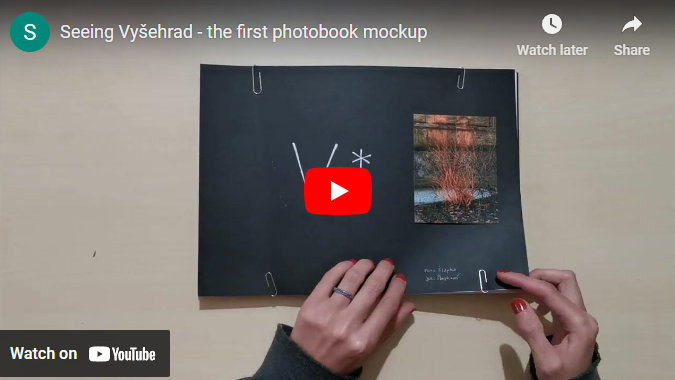The process of creating a photo book
From an idea to a sequence
Crafting a personal visual story: a journey through our photo book creation and what we learned by making Seeing Vyšehrad
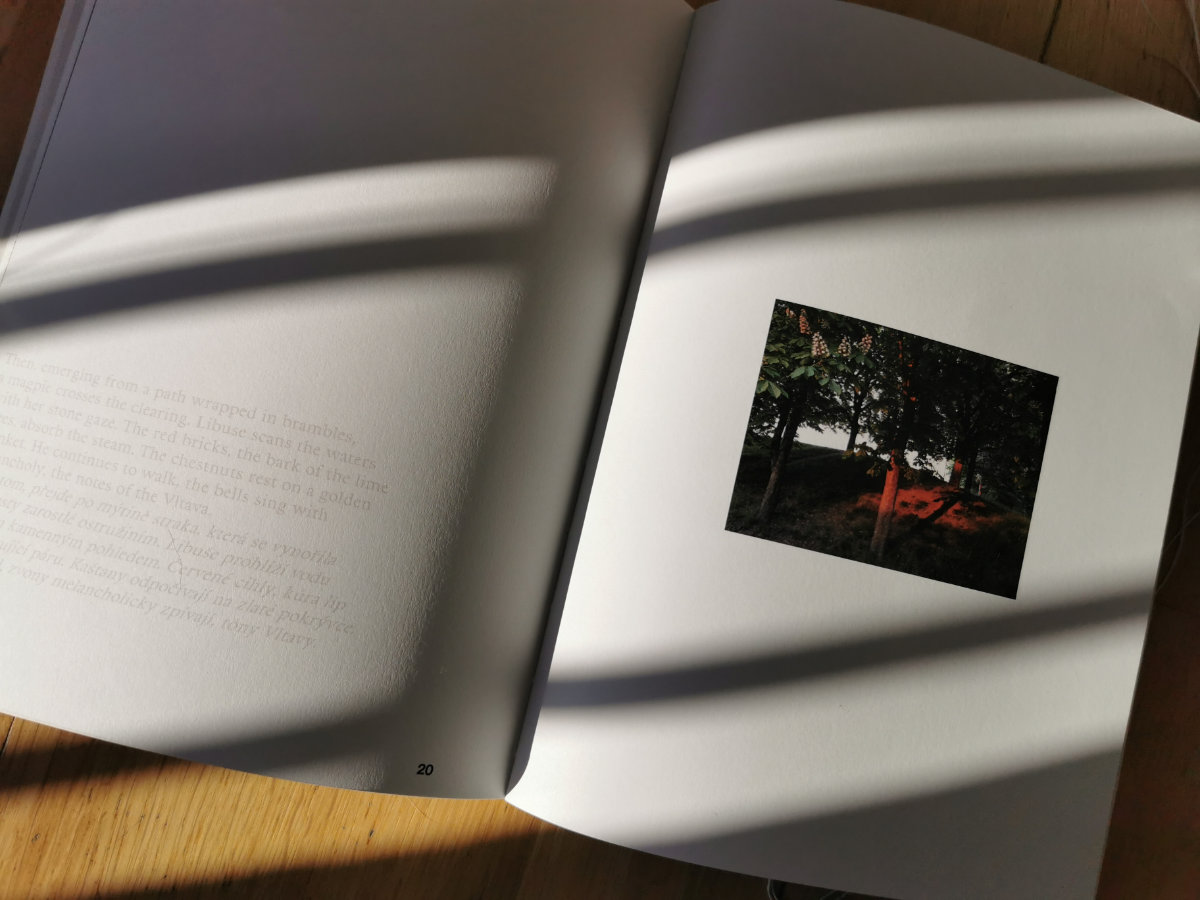
Seeing Vyšehrad photobook
The path of crafting a photo book is a nuanced and unpredictable voyage. At its core, the act of fashioning your very own visual narrative hinges on every selected or consciously omitted image. This creative journey is akin to a winding road, indifferent to your readiness or the external forces that may sway it. There are moments when it can feel stifling and unyielding, tempting you to abandon ship. Yet, there are also instances when it exudes empowerment and elation, compelling you to persist in the exploration. Such is the nature of the captivating odyssey known as photo book creation.
We would like to remind the readers that this process is our personal experience and as such it might differ from someone else’s or your own. There is not one way to go through these phases and they do not always flow in the same order. We’d love to hear the readers’ experiences and how they might have done things differently.
Until then, here’s one of the many ways the process could go. Happy reading!
Ideation
Your initial idea might feel like the ultimate eureka moment. You fixate on it, bubbling with enthusiasm, eager to snap it into reality. It’s your North Star, a long-cherished concept that’s finally taking shape. You head out into the wild, camera in hand, determined to capture the essence of your brainchild. Click by click, you’re on a mission to transform your vision into pixels. As you upload or develop your photos, you’re convinced your concept will shine crystal clear.
All of a sudden, it hits you like a ton of bricks — your idea seems to have pulled a disappearing act. Panic creeps in as you realize how much precious time you’ve spent on this quest. Self-doubt kicks in, and you begin to wonder if your brilliant idea was, in fact, not so brilliant after all. Is it even okay to consider a change? Thoughts whirl through your mind at a million miles an hour. Then, like a hidden puzzle piece revealing itself, you start spotting patterns in your images and your puzzle seems to fall into place. Ah-ha! There she is — the idea you thought had gone MIA (missing in action, edit). How could you have missed it in plain sight?
Some time of your ideation is likely devoted to research: you research if other photographers proposed something similar or if none ever did. If anything piqued your interest and inspired further development, you could refine your idea and react to your findings.
Categorization and feedback loop
You find yourself in a seemingly endless cycle of sifting through your digital photo collection, repeatedly scrolling, clicking, and swiping in a tireless effort to categorize and organize this digital visual universe. You sort, label, tag, and arrange your snapshots by date, event, location, and even emotion, creating intricate folders, albums, and tags that bring order to the chaos of your memories.
The process involves reevaluating, reviewing, and reorganizing each image meticulously, as you strive to capture the essence of those fleeting moments and make your digital gallery an easily navigable and beautifully curated visual journey.
Your desk is bursting at the seams, and you’ve resorted to spreading out on any other available surface. It’s a critical time when you must acknowledge that, despite your best efforts to maintain digital order, the true test comes in the form of printed images. In essence, the floor becomes your canvas for realizing that only when you see your images in tangible print can you truly grasp the coherence and impact of your idea.
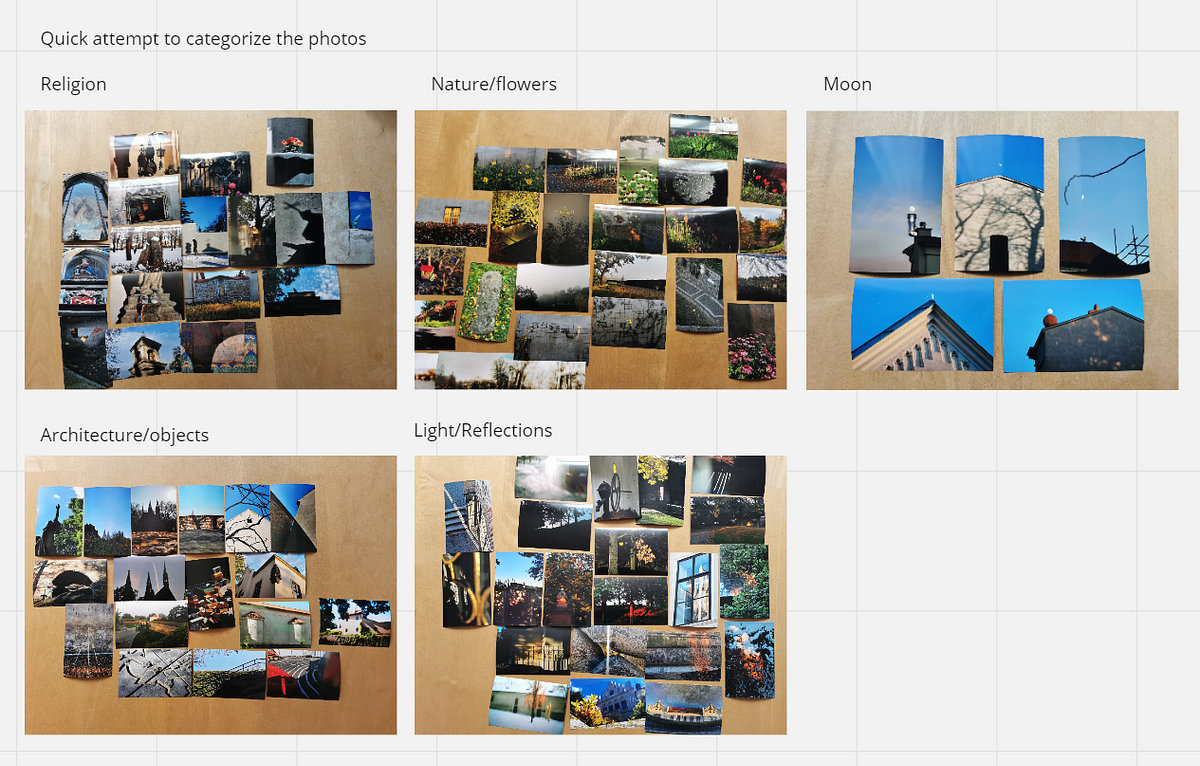
Categorization
The categorization process remains a black box, as we initially attempted to assemble our images thematically. We sought to group subjects of a similar type, to determine which images would earn a coveted spot in the book, which ones left us skeptical, and which were summarily dismissed with no possibility of reprieve.
We strongly recommend the practice of never truly discarding any image, but instead, temporarily shelving it out of view. Later, reintroduce it into the mix to gauge whether it sparks dissonance. If the dissonance aligns with your creative intentions, the image may earn its place; otherwise, it’ time to part ways. This is a phase dedicated to the meticulous observation of your work’s breadth, initiating the process of refining your focus and decluttering both your mental and physical workspace. At this juncture, consider reaching out to a mentor, or a friend, or even engaging in guerrilla testing by soliciting the thoughts of impartial observers. The outcome of this moment can swing between uplifting and disheartening, and it can be a solitary experience if you opt to keep it to yourself.
If you choose to keep this phase entirely to yourself, there’s a considerable risk of constructing an echo chamber around your creative process. An echo chamber, in this context, refers to a closed-off environment where your ideas and perspectives are constantly reinforced by your own thoughts and judgments. While this might provide a sense of comfort and assurance, it can also stifle your creative growth.
Deep down I knew that the book was not ready. There was more digging to do before the book would find true maturity and presence.
Creativity often thrives in the crux of challenge and external input. When you’re isolated in your creative bubble, you may miss out on the valuable opportunity to weather crises — moments when your ideas are put to the test, and you must adapt, pivot, or even discard them altogether. It’s during these challenges that creativity is frequently heightened and innovation emerges.
The external perspectives and fresh insights that come from sharing your work with others can provide a much-needed breath of fresh air, exposing blind spots and inspiring new directions that you might never have discovered in isolation. So, while solitude has its merits, seeking external input can be a vital ingredient in fostering a more robust and innovative creative process.
Concept and inspiration
Hold on now, weren’t you supposed to be at this phase before? Does not this belong to the ideation phase? Yes and no.
The distinction between the “Concept and Inspiration” phase and the “Ideation” phase might seem a bit blurred, but there’s a valid reason for treating them separately. While both phases involve generating ideas and finding inspiration, they serve distinct purposes in the creative process.
“Concept and Inspiration” is about refining and solidifying the core idea that will drive your project. It’s the point where you start envisioning the specifics of your creative endeavor. You’re not merely brainstorming; you’re honing in on a particular concept that will guide your work.
On the other hand, “Ideation” is a broader brainstorming stage. It’s about generating a wide array of potential ideas, without the commitment to a single, refined concept. This phase is more exploratory, where you’re casting a wide net to capture any and all ideas that might later contribute to your project.
In essence, while “Concept and Inspiration” may seem like it overlaps with “Ideation,” it’s where you go from a multitude of ideas to a single, well-defined concept that will be the backbone of your creative work. The separation allows for a more focused and purpose-driven approach to crafting your project.
In this phase, you have a toolbox of creative aids at your disposal. You can employ the power of mental maps and collaborative boards like Miro to refine and crystallize your primary concepts. Alternatively, you may choose to pin your most cherished learning resources for future reference. Whether it’s wielding a trusty pen on paper or adorning your creative corner with sticky notes, it’s your canvas for ideation. Surrounded by the comforting presence of your plants, a warm cup of coffee or tea, and perhaps the company of your feline friend, you’re free to weave narratives, construct scenarios, and annotate inspirational quotes and musings. It’s a space for unfettered creativity to flow and ideas to take shape.
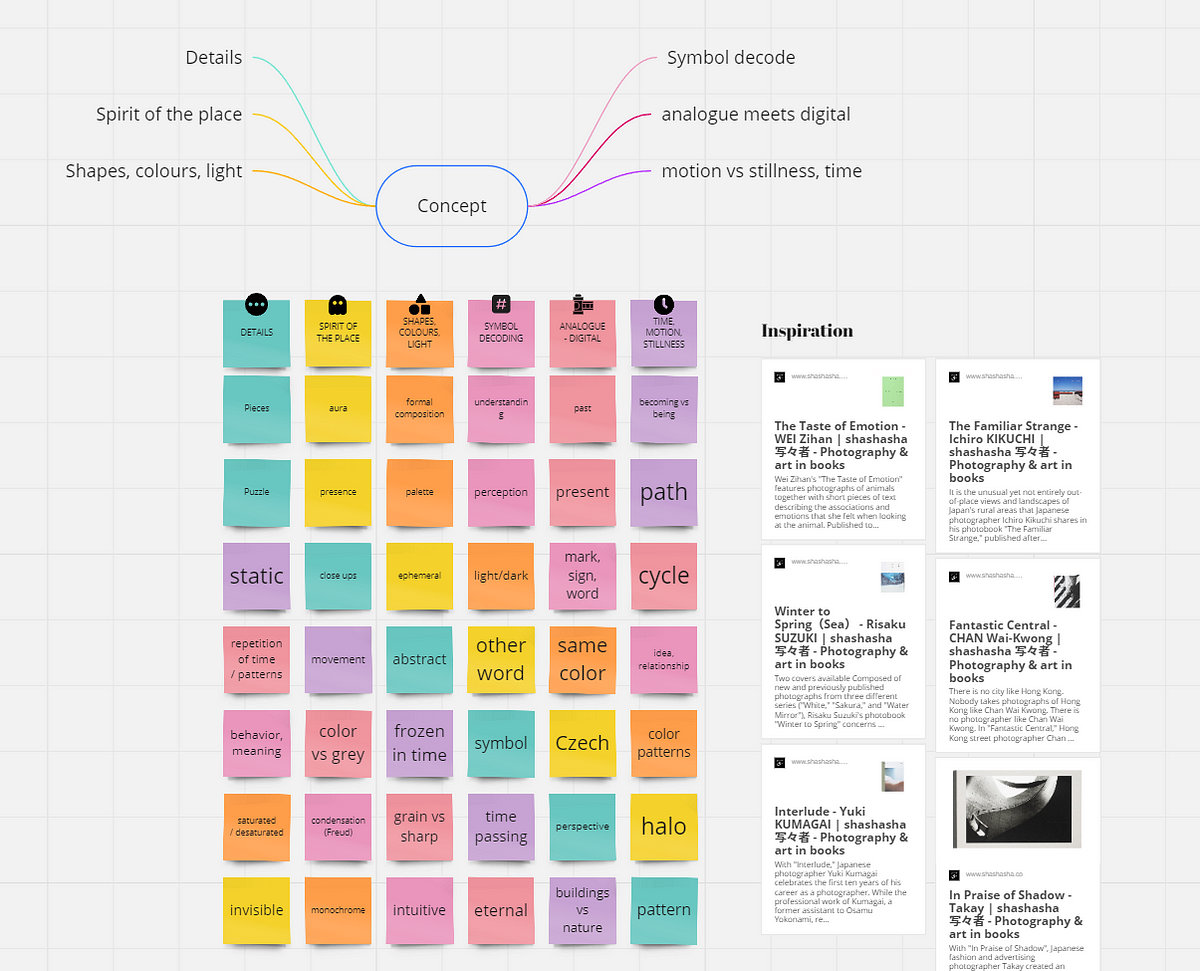
Miro board
Sequencing
As your concept takes shape, it’s time to consider how it will be visually represented in the final project. This involves continually zooming in and out of your arranged photographs, asking yourself: what story do I want to tell? The answer to this question should be reflected in your image flow or sequence.
If you’ve successfully curated a selection of photos that aligns with the central theme, your next step is to assemble them. Based on the narrative you wish to construct, photos can be juxtaposed in various ways. However, it’s crucial to isolate each photo and then view it in proximity to another. We learned it the hard way: continue working with printed photos! Haptics play a vital role, if you can feel the medium and you can move it around, your eyes start seeing patterns you would not easily see while on the screen. There is a certain connection with the physical thing that no screen could ever achieve.
Conventionally, two photos are placed side by side. However, many contemporary photographers opt for three or more images on a single page, creating intriguing compositions. When two photos are visually powerful or carry significant visual weight, they may vie for attention, disrupting the flow as the viewer expends excessive cognitive effort processing both images.
In such cases, it’s advisable to maintain a distance between the two dominant photos, allowing space and interspersing them with less prominent ones. This provides viewers with breathing room, enabling them to grasp the story the sequence aims to convey.
There will be images that you’ve taken that really speak to you, but perhaps wouldn’t be ‘enough’ to stand alone as an Instagram post. Those are the photographs that are given space to breathe in a zine, and it’s wonderful to be able to give them life outside of your hard drive.
The abundance of materials at your disposal also demands careful consideration. If, like us, you embrace the versatility of mixed media, ensure its integration into the sequence, as it offers a unique spectrum of artistic expression and emotional resonance.
We embarked on an experimental journey, merging our photographs using overlays, and blending two distinct photographic techniques. We manipulated the photos using various layouts, creating dynamic compositions that defied traditional boundaries. To complement the visual narrative, we incorporated snippets of poetry crafted from our hearts and minds.
Our exploration extended to negative space, the void that surrounds and interweaves the photographic elements. We experimented with different positioning, challenging conventional expectations and inviting the audience to engage in a dialogue in the absence of visual information.
We embraced the power of black as a backdrop, allowing the photographs to emerge with a captivating intensity, their essence amplified by the stark contrast. Additionally, we created maquettes, and miniature models of the final layout, enabling us to rearrange and refine the composition until it achieved the desired balance and emotional impact.
The first mockup
Remember, the crafting process need not be confined by financial constraints; a matchbox-sized miniature can serve as a canvas for artistic expression, and repurposed papers or recycled materials can be transformed into unique and evocative elements.
This phase of the creative journey is one of unbridled imagination, where decisions are guided by emotions and intuition rather than rigid design rules. We encourage you to embrace the fluidity of this process, allowing your passion and creativity to guide you toward a visual narrative that resonates deeply with your audience.
Mixed media: printing experiments, overlays, poetry
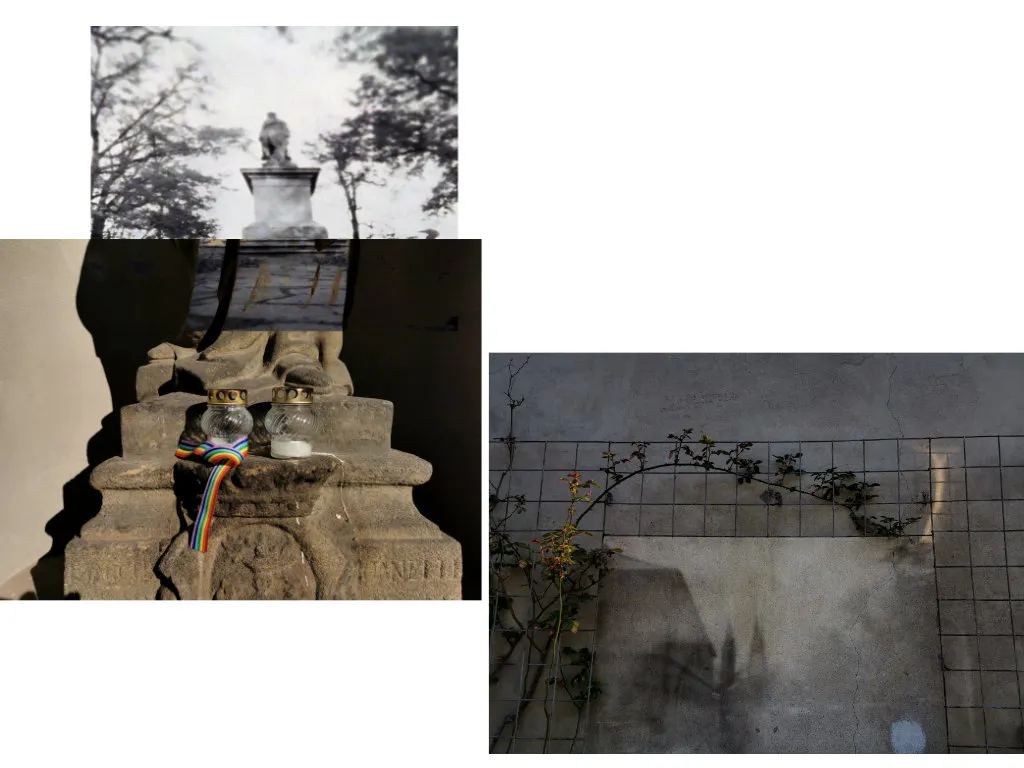
experimenting with digital editing and combining pinhole and digital photos
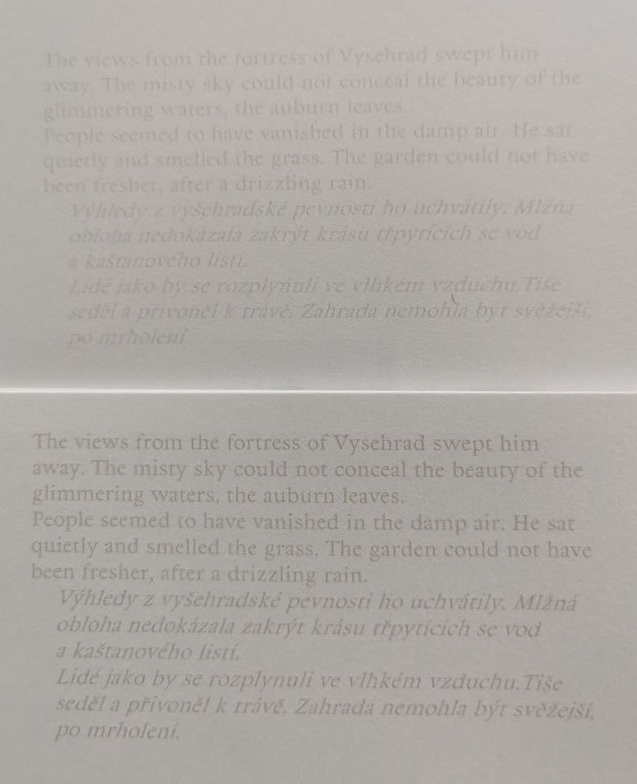
printing and adjusting text color (the version above is not legible)
Mentorship and why it is so powerful
The photography critic and curator Vince Aletti, who also won this year’s PhotoBook of the Year award (2023), says there has to be:
A particular attention to the book as an object, in which the selection of images, sequence, scale, typography, and materials are all carefully considered.
We considered these aspects and talked to photographers like David Gaberle, photography curators like Eefje Ludwig, photography teachers like Ligia Berg, and designers like Laura Morovska to help us create a high-quality book we would be proud of.
Contact us to get a copy.
